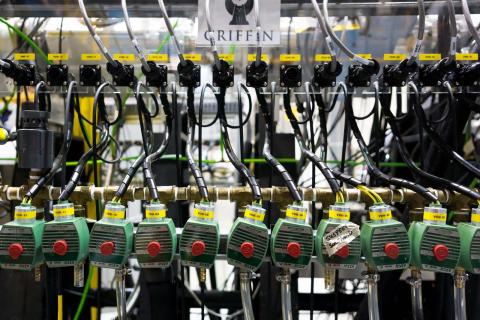
New state-of-the-art facility for decay spectroscopy begins operation at ISAC
A collaboration of Canadian scientists has been developing Gamma-Ray Infrastructure For Fundamental Investigations of Nuclei (GRIFFIN), a state-of-the-art instrument for detecting and measuring gamma radiation with high efficiency and precision, since 2011. Researchers will use the GRIFFIN facility to probe the atomic nucleus and study the interactions between the constituent protons and neutrons. GRIFFIN will support a broad range of research in three major fields: nuclear structure, where it will help unveil nuclear properties and how they change with varying numbers/ratios of protons and neutrons; nuclear astrophysics, where it will look at features of nuclei thought to be crucial to how the heavy chemical elements are formed in the universe; and fundamental symmetries, where it will perform precision studies of super-allowed Fermi beta decay as well as measurements for the Radon Electric Dipole Moment (Rn EDM) program at ISAC.
It has been an exceptional year for the GRIFFIN collaboration. The first six months was an intense period of hardware installation work at ISAC to get the new beamline, electronics enclosure and spectrometer equipment on the floor. During the week of September 15–19, the new low-energy beam line for GRIFFIN was successfully brought online. On September 24, the facility was delivered its first radioactive isotope test beam (Sodium-26) to commission the operation of the new digital data acquisition system and detectors. The following week, GRIFFIN successfully completed its first early-implementation physics experiment using a Silver-115 beam to investigate how the isotope Cadmium 116 is produced in stars. In early December GRIFFIN was used to study the properties of excited states in Magnesium-32, as well as excited states in Calcium-46 and Calcium-47. The detailed data analysis of these experiments is now underway and the results are expected to be released next year.
“It is very exciting to see this powerful instrument turn on, which will make a tremendous difference in the investigation of very exotic nuclei and the hunt for very subtle effects of new physics,” said Reiner Kruecken, Head of the Science Division at TRIUMF. “With a sensitivity of up to 300 times better than the very successful 8pi spectrometer, GRIFFIN will be a game changer in the decay spectroscopy of rare isotopes."
GRIFFIN was awarded $8.9M in 2011 through the Canadian Foundation for Innovation (CFI), TRIUMF, and the University of Guelph to complete the first phase of the project. Professor Carl Svensson from the University of Guelph and TRIUMF’s Dr. Adam Garnsworthy led the project design and installation, which was completed more than 6 months ahead of the original project schedule.
GRIFFIN consists of an array of 64 hyper-pure germanium crystals arranged into sixteen “clover” detectors - sets of 4 coaxial crystals are machined to specific shapes and mounted in a common cooling module to form a structure resembling a four-leaf clover. All sixteen clover detectors have now been delivered, have passed the full set of acceptance tests performed under the direction of Professor Kris Starosta of Simon Fraser University, and are on-site at TRIUMF and available for research with GRIFFIN.
In addition, GRIFFIN utilizes a new digital data acquisition (DAQ) system custom designed and built by Jean-Pierre Martin of the Université de Montreal and the TRIUMF Electronics Development Group under the direction of Daryl Bishop. Chris Pearson of the TRIUMF DAQ Group led the firmware development and implementation of these modules into the GRIFFIN DAQ system, which demonstrated excellent performance in the autumn 2014 commissioning and first physics experiments with GRIFFIN.
“This successful design, construction and installation project would not have been possible without the many contributions of TRIUMF service groups and personnel. The GRIFFIN collaboration is very grateful for these efforts,” said TRIUMF Research Scientist, Adam Garnsworthy. “It is fantastic to be performing the first experiments and see all the hard work paying off.”
The GRIFFIN collaboration’s efforts are now focused on integrating the full set of ancillary detector systems into GRIFFIN and coupling the CFI-funded DESCANT neutron detector array with GRIFFIN to enable studies of very neutron-rich nuclei in 2015.
–by Adam Garnsworthy, TRIUMF Research Scientist
Bottom photo courtesy of Sean Birch.
